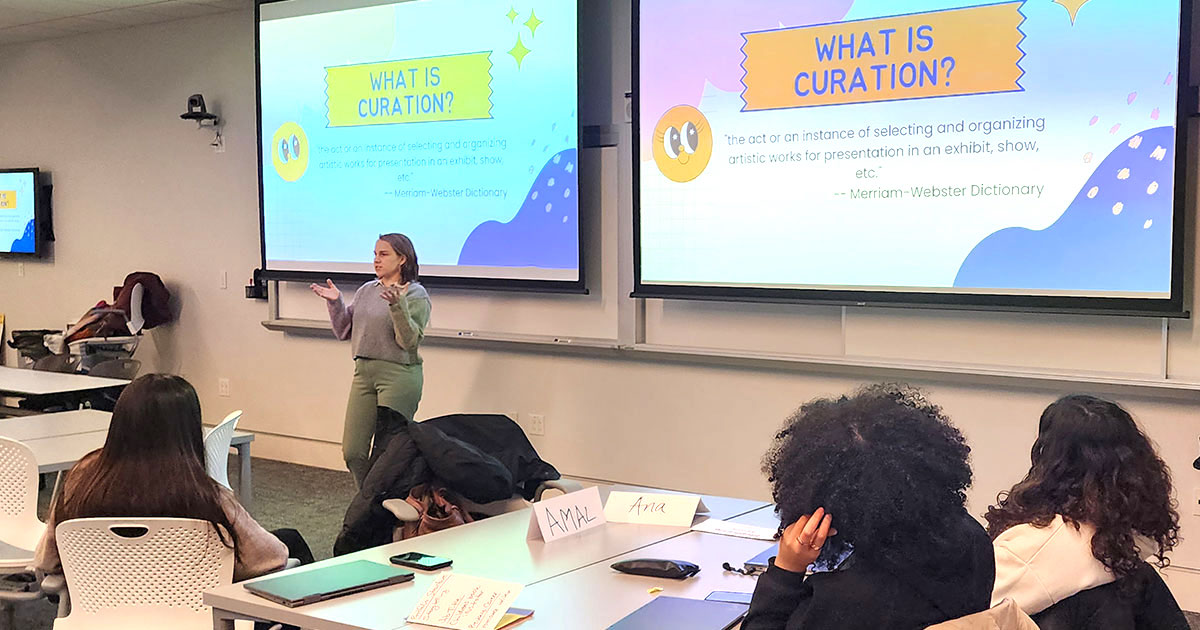Job-Search Lessons: How to Make a Portfolio

While looking for work, people typically spend a lot of time tinkering with their resume and cover letter. They may be ignoring, however, a potent tool for their search.
“People don’t usually consider portfolios unless they are required,” says Maria Herwagen ’23. “I am trying to encourage people to have portfolios. I see it as a third piece to the cover letter and resume.”
This semester, Herwagen talked about the power of portfolios in a senior-led seminar, a popular program in which Babson seniors teach a noncredit, five-week course on their interests to fellow students. In Herwagen’s seminar, Skill-Driven Portfolio Building, she took attendees through the process of how to make a portfolio and made the case it’s a useful way for job seekers to stand out in a wide range of fields.
“It always feels like a competitive environment. I’m hoping to take a little worry away from that,” says Herwagen, who is graduating in May and is in the middle of her own job search, looking for a position in data analytics. “Here is something that tangibly can be good for you. The more I thought about it, I realized that students really need this.”
Students aren’t the only ones. For anyone interested in exploring the potential of portfolios, Herwagen offers some key advice.
Why Make a Portfolio
Before examining how to make a portfolio, Herwagen touches on why someone should put one together in the first place.
Portfolios serve as showcases of one’s work and talents, and many might assume that they are best meant for creative endeavors such as art, writing, modeling, or photography. Herwagen asserts, however, that when applying for any number of positions—product design, project management, software engineering, data analytics, any type of leadership role—job seekers should include a portfolio.

“Just because a job field doesn’t traditionally use portfolios doesn’t mean you can’t throw one in there. It’s honestly applicable to so many jobs you don’t realize,” Herwagen says. “If you put a little thought and care into it, it can only be helpful.”
Going that extra step of including a portfolio shows a job seeker’s interest in a position. “It shows that I really do want this job,” Herwagen says. It also lets potential employers learn more about a candidate and gives them another thing to ask about in an interview.
This is especially helpful if candidates are trying to highlight skills or experiences that are outside of what’s shown on their resume. Maybe they have a hobby or side hustle that involves relevant expertise. “A portfolio allows you to showcase personal skills that can be still relevant,” Herwagen says.
How to Make a Portfolio
To put together a portfolio, Herwagen says there are a variety of digital platforms available. Portfolium, for instance, caters to college students and recent graduates, while Herwagen uses GitHub, which is good for showcasing code.
Once a digital platform is chosen, the next step is to load it up. Don’t worry about organizing things, at least at first. The goal is simply to identify all potential samples you might want to use. Think broadly. Leaders might include exercises and projects done with their teams. Students might include work done for class or a club.
“People don’t usually consider portfolios unless they are required. I am trying to encourage people to have portfolios. I see it as a third piece to the cover letter and resume.”
Maria Herwagen ’23, who taught Skill-Driven Portfolio Building, a senior-led seminar
“Start with collecting everything,” Herwagen says. “Dump everything that can possibly go into a portfolio.”
Then comes curation and organizing. Make sure the portfolio is easy to navigate and its fonts are easy to read. Think about different ways to structure the portfolio, whether by skills, projects, or chronological order. Herwagen makes sure to highlight her expertise in various programming languages. “Here is everything I did in R. Here is everything I did in Python,” she says. “I am trying to showcase as many different skills as possible.”
Why a Portfolio Is Never Done
Just because your portfolio is filled up doesn’t mean it’s finished. “This is a process that never ends,” Herwagen says.
If there’s a type of skill missing from the portfolio that job seekers wish they could highlight, Herwagen says they should go out and get that experience. Volunteer for a business or nonprofit, offering to do work in the very skill that’s missing. “There are so many places that could use their talent,” Herwagen says.
If applying for a job, consider tailoring the portfolio to the position. “You are ideally tweaking the portfolio to whatever job you are applying to,” Herwagen says. “Obviously, that is time consuming.”
Even when job seekers land their dream position, they shouldn’t put their portfolio aside. They should always be updating it so it’s ready for the next job search. “If you work on a project you’re excited about at work, put it in your portfolio,” Herwagen says. “It is helpful to be checking in with yourself and seeing what else you can put in it.”
@babson_college; At Babson College Senior-Led Seminars, our graduating students have the chance to teach their peers about topics they are both knowledgeable in and passionate about. #CareerAdvice; #BabsonCollege; #HigherEducation; ♬; Summer – Aesthetic Sounds






